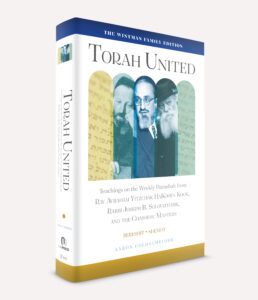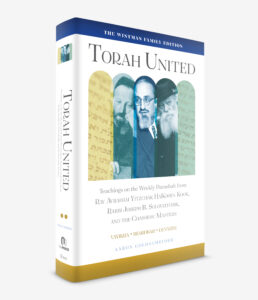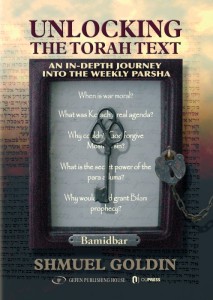Excerpted from Rabbi Dr. Norman J. Lamm’s Derashot Ledorot: A Commentary for the Ages – Leviticus, co-published by OU Press, Maggid Books, and YU Press; edited by Stuart W. Halpern
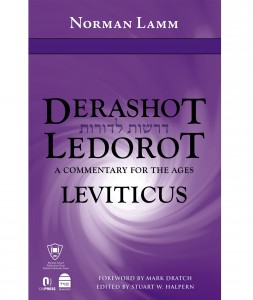 Something Different for a Change*
Something Different for a Change*
The problem of tradition versus innovation is an ancient, complex, and yet ever relevant one. The issue has never been fully resolved, and especially in Jewish life we must face it again in every generation.
When does conformity with accepted custom shade off from cautious conservatism to a rigid reactionary stand? And when does the willingness to experiment move one from the ranks of the liberals to those of the radicals who are contemptuous of the inherited values of the past? When is submission to tradition an act of moral cowardice and an evasion of responsibility, a cop-out on independent thinking? And when is the desire for change a thoughtless lust for cheap sensationalism and trivial thrill? These are questions of the greatest importance, and honorable men and women have and do differ about them.
It would be foolish to attempt an exhaustive analysis of the point of view of Judaism on this question, but is instructive to look for some insights from within the heritage of Judaism.
A perusal of the first part of today’s sidra impresses us with the Torah’s powerful insistence upon observing every jot and title of the tradition. Thus, the Yom Kippur service of the High Priest in the Temple is set forth in the greatest detail, with constant and reiterated warnings that the slightest deviation from the prescribed ritual is a disaster, that any change is calamitous. Clearly, the Bible holds tradition and custom in the highest esteem.
And yet, here and there the Torah leaves us a hint which the Rabbis picked up and expanded, in order to complete the total picture by supplementing this valuation of tradition with another point of view. Thus, after describing the high point of Yom Kippur, when the High Priest has performed the service in the inner sanctum, we read, “And Aaron shall come to the Tent of Meeting and remove his linen garments which he wore when he came to the sanctuary, and he shall leave them there” (Leviticus 16:23). The Talmud (Pesaĥim 26a, and cited by Rashi) tells us that of the eight special garments that the High Priest wore for the Yom Kippur service, he was to remove four of them, those of white linen, and these required sequestering or burial. They could not be used again. He may not avail himself of these four garments on the following Yom Kippur.
Now, these priestly clothes were very costly linen garments. According to the mishna in Yoma (3:7), they were exceptionally expensive. Why, therefore, waste them? Why not put them aside for the following Yom Kippur? Why do not the Rabbis invoke the established halakhic principle (Yoma 39a) that, “The Torah is considerate of the material means of Israelites” and does not want to spend Jewish money unnecessarily?
An answer has been suggested by Rabbi Mordechai HaKohen. With all the concern of the Torah for the prescribed ritual and the unchanging tradition, the Torah very much wanted us to avoid the danger of routine. It considered boredom and rote as poison to the spirit and soul. Therefore, whereas we must follow every step of the ritual, the High Priest must have a change of garments every Yom Kippur, in the hope that the outward novelty will inspire and evoke from within the High Priest an inner freshness and enthusiasm, and that these four garments, which must always be different and always be new, will remain a symbol to all Israel that boredom is a slow death for the spirit, that only renewal can guarantee life. We need something different for a change!
What I think is the authentic Jewish view on our problem of tradition and change is this dual approach, insisting upon the unchanging framework of action, the fixed pattern of activity being transmitted from generation to generation without the slightest deviation, but demanding at the same time that inwardly we always bring a new spirit, a new insight, a new intuition into what we are doing. Objectively there is to be only tradition; subjectively there must always be something different, some change, something new. In outward practice custom prevails; in inner experience, only novelty and growth.
We find this emphasis on internal novelty in all the branches of the Jewish tradition. The Halakha itself, which is so insistent upon preserving outward form, cautions us against merely rote observance of mitzvot to which we habituate ourselves. It is very important for every man and woman to learn how to give religious expression to the various aspects of one’s life, but never must this be done thoughtlessly and mindlessly merely because it has become second nature for us. Every year we perform the same seder, but our tradition challenges us to pour new meaning into the old form. Every Jewish wife and mother lights the candles on Friday afternoon in the same way every week of her life. It is her great opportunity to offer her own personal, even wordless, prayer to her Creator. But every week there should be some novelty, some additional requests, some new insights and concern – perhaps for someone else’s family. When we offer the blessing on bread after a meal, we recite the same words, but perhaps sometimes we ought to vary the melody (if we do sing it) in order to challenge us to rethink our gratitude to the Almighty for being allowed to be included in that small percentage of humanity that suffers from overeating rather than under-eating. Every morning we recite the morning blessings. If we would really hear what we are saying, it is possible that our service would take three times as long! We bless God who is “poke’aĥ ivrim,” who makes the blind see. Only a short while ago we were sleeping, completely sightless. Then we wake up and look at the world around us. We ought to marvel, we ought to be amazed and stunned, at the great miracle of being able to see!
Ask those who cannot, whose eyesight is impaired, or whose vision is threatened, and you will appreciate once again what it is to wake up every morning and be able to see! We blessed Him that He is “matir asurim,” He straightens up those who are bent over. We thank God that we are able to get up in the morning, difficult as it is, and indeed, when we think upon it, we ought to be suffused with a special light of thankfulness that we are not confined to bed, that we have the wherewithal to arise and go about our daily activities. Every word of prayer that we say, every expression of gratitude, ought to be completely new every morning. And indeed, this is true for objective reasons as well. Although the world looks like an old one, although the objects of nature are ancient and its laws timeless, nonetheless we believe that God “renews in His goodness every day the work of Creation.” In that case, every morning we are indeed confronted with a brand new world – and therefore our reaction ought to be one of novelty and amazement and marveling.
The Kabbalistic tradition, as it came to us through Rabbi Isaac Luria, insisted that the same holds true for all of prayer. In prayer, perhaps above all else, we find the Jewish penchant for tradition and the acceptance of tried and tested formulae. Unlike most other peoples, especially in the Western world, our tefillot are the same every day, every Sabbath, every festival. And yet Rabbi Isaac Luria taught that each prayer must be unique in its essence, despite the identity of words. No two prayers are ever alike! Each prayer is offered up only once and cannot be truly repeated – provided that we pray in the right manner.
Hasidism made this the cornerstone of its whole theology. Thus, Rebbe Nachman Bratzlaver declared that, “If we shall be no better tomorrow than we are today, then why is tomorrow necessary at all?!” We may not use the same garments of this year for next Yom Kippur. There must always be something different, for a change in the life of the spirit is necessary to keep the mind and heart alive, healthy, and alert – to make each and every tomorrow unexpected, meaningful, exciting, and hence, necessary. There must be a change – and always in an upward direction.
Paradoxically, if we remain the same, we really are diminished. If we are stationery, then we are not stationery but we retrogress. In the life of Torah, the old rule (Sifre, Eikev 48) holds true – “If you abandon it for one day, it will abandon you for two days.” Why is this so? Because life moves on, turbulently and inexorably. Events are never static; we have to run to keep in place.
This is especially true with the mitzva of tzedaka, charity. I am often frustrated when I appeal for charitable contributions and I hear the answer to my appeal in the form of a question: “Well, what did I give last year?” In all other aspects of life, we accommodate ourselves to a precipitate change in the economy. Despite an ephemeral boycott or occasional whimper or complaint, we adjust soon enough to paying more for beef and onions, for haircuts and services. But when it comes to charity – rarely do we keep pace. “What did I give last year” becomes the introduction to and excuse for repeating the same pledge this year. This question and this pledge form a philanthropic litany which is destructive of our greatest communal institutions.
But this is not the way it should be. We may not use the same garments of this year for next Yom Kippur. Just as in matters of prayer or observance or religious experience, so in matters of charity we must grow Jewishly. Here too there must be something different for a change. Today must not be the same as yesterday, tomorrow not the same as today, this year not the same as last year.
Perhaps all that I have been saying is summed up in the last will and testament of one of the greatest Jewish translators of the Middle Ages, Rabbi Judah Ibn Tibbon, when he left the following advice to his son, Rabbi Samuel: “Of what good is life if my actions today are no different from what they were yesterday?” And conversely, how wonderful can life be if every day is new, if every day is different, if every day there is a change for the better.
*April 28, 1973
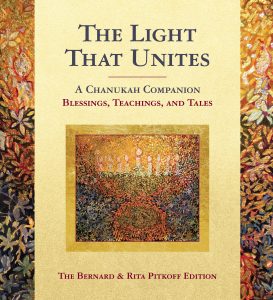 The Teaching of A Single Candle
The Teaching of A Single Candle
